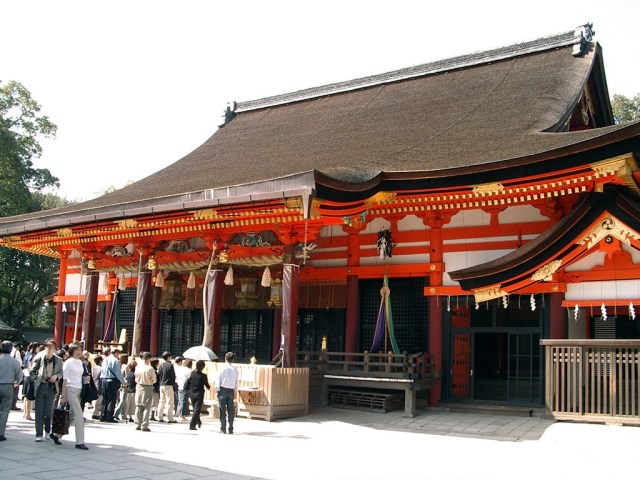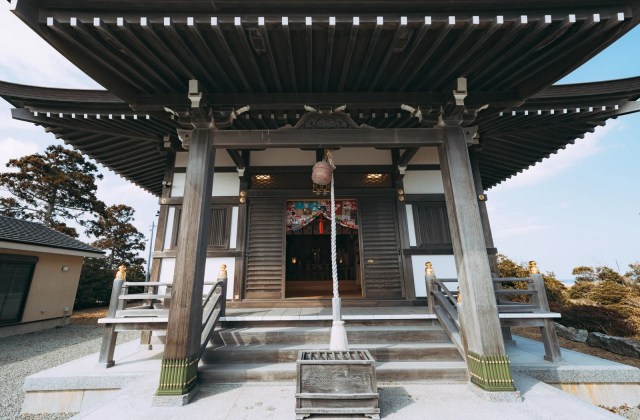
Shinto shrine tradition no longer possible for nighttime visitors.
Construction for Kyoto’s Yasaka Shrine was founded in the seventh century, and it sits right in the middle of Gion, the city’s geisha quarter. That combination of cultural significance and easy-to-access location has made Yasaka Shrine one of Kyoto’s most popular sightseeing attractions, but following a recent incident involving some nighttime foreign visitors, the shrine has made a change to its operating policies, removing a traditional part of the Shinto shrine experience after sundown.
Shinto shrines typically have a collection box for donations that can be found in front of the building that houses the main alter. Visitors toss their coins into the box, then ring a bell mounted above the box by shaking a cord before offering prayers or making a wish. These bells aren’t the large, cast-iron ones whose notes echo throughout the surrounding neighborhoods. They’re about the size of a basketball and have a ringer inside, so there’s no need to use all that much strength in shaking the cord.
▼ Though not Yasaka, the setup at the shrine shown in this photo is pretty much the standard.
Yasaka Shrine has three such bells, and they could be rung at night, even after the shrine staff has left for the day. However, last week a video was posted online in which a Japanese woman confronts what appears to be a group of foreign tourists who had been ringing the bells with excessive force.
Unfortunately, there doesn’t seem to be any video of the ringing itself, but in the conversation that followed, one side was clearly much more heated than the other.
#拡散希望 鈴緒を柵に叩きつけて遊びながら参拝していた外国人を注意したところ、多人数から罵られ続けました。これが夜の八坂神社の実態。#オーバーツーリズム #観光公害 #京都 #八坂神社
— 藤野 (@fujino_ojo) May 23, 2024
もう手に負えません…みなさん助けてください。 pic.twitter.com/iCWrlXTX0b
“Enough. Enough. Enough. Enough. Get out of my sight,” one of the foreign men can be seen telling the woman, before another, who eventually states that he’s been a resident of Japan for eight years, steps forward and presents himself as the group’s spokesperson. After rapidly asking the woman three times in English, if she speaks English, he switches to grammatically sound if accented Japanese to ask her again if she can speak English, then bounces back to English before telling her to leave them alone. A foreign woman then comes forward to say “I misunderstood and I made it too loud. It’s not his fault,” after which the second man jumps back in and declares “You’re being very rude. Leave us alone.” Any pretext of polite conversation then breaks down, with the woman and second man both declaring each other rude in less-than-courteous choices of vocabulary.
The video was uploaded to Twitter on May 23, and two days later Yasaka Shrine posted the following announcement on its official website:
“Out of concern for the safety of all visitors, we will be putting away the main hall’s bell cords from 5 p.m. to 6 a.m. During that time, you may visit and worship as usual, but please be aware that you will not be able to ring the bells.”
▼ The bell cords being raised, following the change in policy
外人狼藉者のせいで、夜間は鈴の緖が上げられることになった八坂さん御本殿 pic.twitter.com/Tzz8xaJFRJ
— 釜玉うどん(おそらく非公式) (@fBJZQlO8fLn5EsT) May 26, 2024
The policy change doesn’t seem to have been triggered only by the May 23 video, as the shrine said, in a follow-up statement, that “There have been multiple cases of visitors shaking the cords strongly, and of the cords tearing, which led us to consider this change.” However, the timing of the policy shift indicates that at the very least the incident shown in the May 23 video was seen as the last straw regarding rough handling of the bells and their cords.
▼ The bells can still be rung during the day, when the shrine staff is present and the cords are in their down position, as shown in the video here.
Yasaka Shrine raising its cords isn’t completely unprecedented, but it’s a measure that’s usually only taken at New Year’s and during major festivals when the large number of visitors would mean significant wear and tear on the cords, and also during the height of the coronavirus pandemic when hand hygiene was a public health issue. In normal times, though, the bells have been available for visitors to ring day or night. The shrine does say, though, that from a religious standpoint not ringing the bell does not hamper the ability of worshippers’ prayers reaching the gods, just like how you don’t have to use a five-yen coin as your offering.
The pandemic years excepted, inbound foreign travel to Japan has been on a steady rise for much of the past 10 years. During the current post-pandemic, weak-yen boom, though, high-profile breaches of etiquette by foreign tourists seem to be occurring with increasing frequency, which risks souring Japan’s feeling towards visitors from overseas. As of now, Yasaka Shrine’s policy of raising the bell cords at night will remain in place indefinitely, but hopefully more respectful behavior from visitors in the coming weeks and months will keep it from becoming permanent.
Source: Yasaka Shrine official website, Nikkan Sports via Yahoo! Japan News via Jin, Kyoto Shimbun
Top image: Wikipedia/Moja~commonswiki
Insert image: Pakutaso
● Want to hear about SoraNews24’s latest articles as soon as they’re published? Follow us on Facebook and Twitter!


 Cute cat finds way to make humans bow down and worship him at Japanese shrine
Cute cat finds way to make humans bow down and worship him at Japanese shrine Feel what it’s like to be a Shinto shrine maiden with shrine’s experience package for foreigners
Feel what it’s like to be a Shinto shrine maiden with shrine’s experience package for foreigners Shinto shrine naked festival ritual asks men to cover up for first time in three-century history
Shinto shrine naked festival ritual asks men to cover up for first time in three-century history A visit to one of Japan’s motorcycle Shinto shrines
A visit to one of Japan’s motorcycle Shinto shrines The only path to this Nagasaki Shinto shrine gets swallowed by the sea every day【Video】
The only path to this Nagasaki Shinto shrine gets swallowed by the sea every day【Video】 Can Kyoto supermarket takeout let you enjoy the local cuisine without fancy restaurant prices?
Can Kyoto supermarket takeout let you enjoy the local cuisine without fancy restaurant prices? Governor of Tokyo releases official AI version of herself as she seeks reelection next month
Governor of Tokyo releases official AI version of herself as she seeks reelection next month Poisonous blowfish instant ramen on the way from Cup Noodle’s Nissin
Poisonous blowfish instant ramen on the way from Cup Noodle’s Nissin Morinaga releases “hunger management” drink that turns into jelly in your stomach
Morinaga releases “hunger management” drink that turns into jelly in your stomach No-bus Kyoto sightseeing! SoraNews24’s ultimate on-foot guide for Japan’s former capital【Part 2】
No-bus Kyoto sightseeing! SoraNews24’s ultimate on-foot guide for Japan’s former capital【Part 2】 Headed to the beautiful island under two hours from Tokyo? This sashimi restaurant is the first place you should go
Headed to the beautiful island under two hours from Tokyo? This sashimi restaurant is the first place you should go Studio Ghibli releases My Neighbour Totoro neckties in Japan
Studio Ghibli releases My Neighbour Totoro neckties in Japan Is Kyoto’s tourist-targeting flavored edamame specialty shop worth its high prices?【Taste test】
Is Kyoto’s tourist-targeting flavored edamame specialty shop worth its high prices?【Taste test】 5 reasons why foreign tourists should skip Tsukiji and go to a different place in Tokyo instead
5 reasons why foreign tourists should skip Tsukiji and go to a different place in Tokyo instead Four words that mean something very different in east Japan and Kyoto
Four words that mean something very different in east Japan and Kyoto You can be on this beautiful Japanese island in less than two hours from downtown Tokyo
You can be on this beautiful Japanese island in less than two hours from downtown Tokyo Studio Ghibli releases new Totoro collection to keep us hydrated all summer long
Studio Ghibli releases new Totoro collection to keep us hydrated all summer long Pizza Hut made a Cardcaptor Sakura Pizza, and its ingredients are as crazy as its looks
Pizza Hut made a Cardcaptor Sakura Pizza, and its ingredients are as crazy as its looks One Piece celebrates 25th anniversary with awesome new Uniqlo T-shirt line tracing series’ history
One Piece celebrates 25th anniversary with awesome new Uniqlo T-shirt line tracing series’ history The Ghibli Park real-world Totoro house’s kitchen and bath actually get used by staff【Pics】
The Ghibli Park real-world Totoro house’s kitchen and bath actually get used by staff【Pics】 Daiso to change Japanese closing-time music because foreign tourists aren’t taking the hint
Daiso to change Japanese closing-time music because foreign tourists aren’t taking the hint The method to save a seat in Japan shows how awesomely safe the country is【Video】
The method to save a seat in Japan shows how awesomely safe the country is【Video】 To combat declining birth rate, Japan to begin offering “Breeding Visas” to foreigners
To combat declining birth rate, Japan to begin offering “Breeding Visas” to foreigners Himakajima: The Japanese island with one traffic light that only turns green once a year
Himakajima: The Japanese island with one traffic light that only turns green once a year Tourist ban now in effect in Kyoto’s Gion geisha district…but are visitors obeying the rules?
Tourist ban now in effect in Kyoto’s Gion geisha district…but are visitors obeying the rules? Tourists damage Mt Fuji Lawson blackout screen that was meant to stop bad-mannered visitors
Tourists damage Mt Fuji Lawson blackout screen that was meant to stop bad-mannered visitors Studio Ghibli Uniqlo shirts and bags on sale now, but not in Japan【Photos】
Studio Ghibli Uniqlo shirts and bags on sale now, but not in Japan【Photos】 Japanese department store rooftop is a secret oasis where you can escape the crowds in Tokyo
Japanese department store rooftop is a secret oasis where you can escape the crowds in Tokyo New Hello Kitty and friends summer kimono are perfect for Sanrio-loving parents, kids, and sisters
New Hello Kitty and friends summer kimono are perfect for Sanrio-loving parents, kids, and sisters Amazon Japan makes payment policy change that could be a problem for foreigners in Japan
Amazon Japan makes payment policy change that could be a problem for foreigners in Japan Tokyo restaurant finds heartwarming way to lure people away from ramen and back to set meals
Tokyo restaurant finds heartwarming way to lure people away from ramen and back to set meals McDonald’s new Happy Meals offer up cute and practical Sanrio lifestyle goods
McDonald’s new Happy Meals offer up cute and practical Sanrio lifestyle goods Sales of Japan’s most convenient train ticket/shopping payment cards suspended indefinitely
Sales of Japan’s most convenient train ticket/shopping payment cards suspended indefinitely Sold-out Studio Ghibli desktop humidifiers are back so Totoro can help you through the dry season
Sold-out Studio Ghibli desktop humidifiers are back so Totoro can help you through the dry season Japanese government to make first change to romanization spelling rules since the 1950s
Japanese government to make first change to romanization spelling rules since the 1950s Foreigner’s request for help in Tokyo makes us sad for the state of society
Foreigner’s request for help in Tokyo makes us sad for the state of society Ghibli founders Toshio Suzuki and Hayao Miyazaki contribute to Japanese whisky Totoro label design
Ghibli founders Toshio Suzuki and Hayao Miyazaki contribute to Japanese whisky Totoro label design Tokyo’s most famous Starbucks is closed
Tokyo’s most famous Starbucks is closed Doraemon found buried at sea as scene from 1993 anime becomes real life【Photos】
Doraemon found buried at sea as scene from 1993 anime becomes real life【Photos】 One Piece characters’ nationalities revealed, but fans have mixed opinions
One Piece characters’ nationalities revealed, but fans have mixed opinions Life-size vibrating Legend of Zelda Master Sword for sale from Nintendo【Photos】
Life-size vibrating Legend of Zelda Master Sword for sale from Nintendo【Photos】 New ‘Shrine Cafe’ in Tokyo offers fortune-telling and counseling services with your tea
New ‘Shrine Cafe’ in Tokyo offers fortune-telling and counseling services with your tea Why buy your cat a cat house when you can buy a cat shrine from Japan instead?
Why buy your cat a cat house when you can buy a cat shrine from Japan instead? TripAdvisor Japan announces the country’s 10 favorite shrines and temples
TripAdvisor Japan announces the country’s 10 favorite shrines and temples Nine places to take unforgettable social media photos in Japan
Nine places to take unforgettable social media photos in Japan Japanese Twitter user posts beautiful photos of what may be Japan’s most picturesque shrine
Japanese Twitter user posts beautiful photos of what may be Japan’s most picturesque shrine Charges dropped against elderly Japanese man for nailing Putin voodoo doll to sacred shrine tree
Charges dropped against elderly Japanese man for nailing Putin voodoo doll to sacred shrine tree Japan respectfully says goodbye to a single bamboo shoot in Kyoto
Japan respectfully says goodbye to a single bamboo shoot in Kyoto Temple bell tolling on Japanese New Year’s Eve gets rid of evil desires, but not complaints
Temple bell tolling on Japanese New Year’s Eve gets rid of evil desires, but not complaints Japanese shrine may have created the most Kyoto-like “wear a mask” reminder ever
Japanese shrine may have created the most Kyoto-like “wear a mask” reminder ever Draw-your-own fox charms are one of the highlights of Kyoto’s famous Fushimi Inari Shrine
Draw-your-own fox charms are one of the highlights of Kyoto’s famous Fushimi Inari Shrine Three reasons you should go to Kyoto right now
Three reasons you should go to Kyoto right now Japanese shrine creates special water fountain for thirsty bees
Japanese shrine creates special water fountain for thirsty bees Kyoto hotel OMO5 Kyoto Gion offers Yojiya cosmetics Pretty Girl Room Stay for New Year’s season
Kyoto hotel OMO5 Kyoto Gion offers Yojiya cosmetics Pretty Girl Room Stay for New Year’s season Akihabara’s otaku shrine celebrates PlayStation 5 launch with ethereal one-night event
Akihabara’s otaku shrine celebrates PlayStation 5 launch with ethereal one-night event This Year of the Rabbit, visit some of the best Japanese sightseeing spots related to rabbits
This Year of the Rabbit, visit some of the best Japanese sightseeing spots related to rabbits Kyoto in summer: A special trip to Kifune shrine recharges the soul
Kyoto in summer: A special trip to Kifune shrine recharges the soul
Leave a Reply